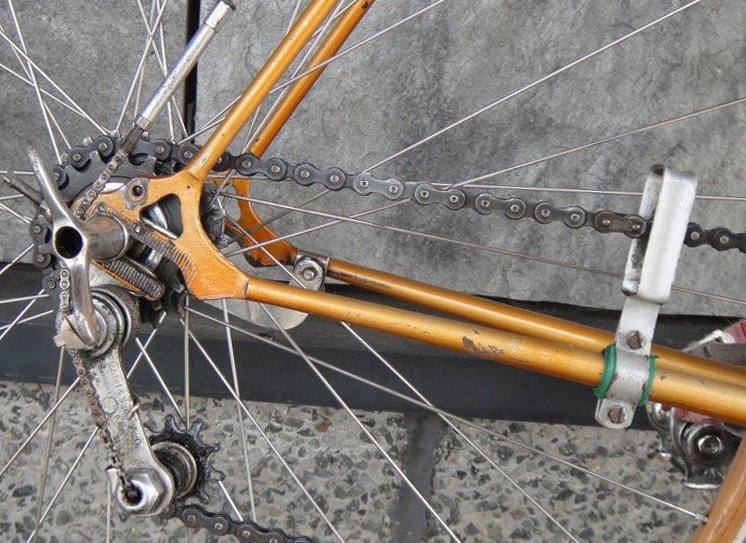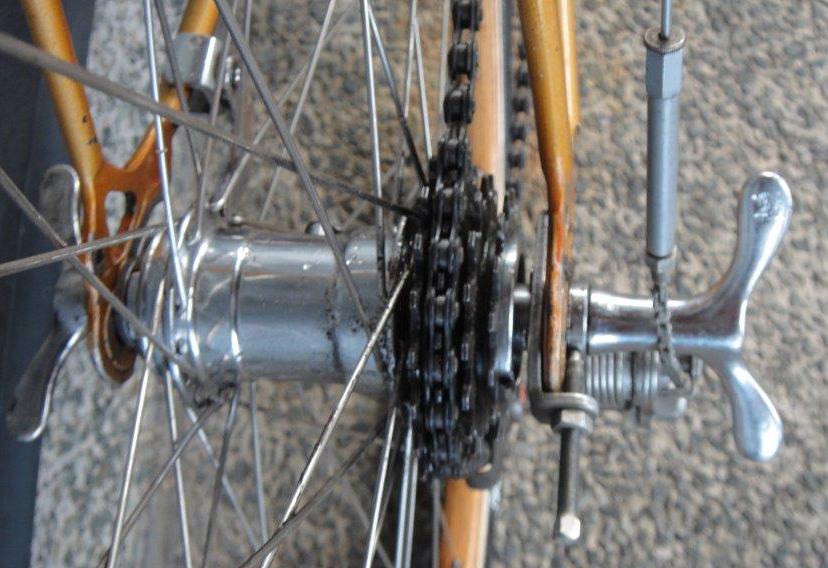Vol. 2, Issue 68 - March / April 2017
Posted: Thursday 16th March 2017
Some of you will know that I came off my bike last year and sustained a fractured hip and elbow. It was my fault for showing off by putting on a rain jacket while riding along, only to lose my front wheel for some reason, resulting in my hitting the ground like a sack of coal.
I heard a loud crack and thought my frame (carbon) must have snapped somewhere. As luck would have it we had a cycle mechanic on the ride and he later told me that the only damage to the bike was a minute scratch on one brake lever. The crack I heard had been my own bones. Needless to say I was wearing a helmet so no damage to the head but the paramedics seemed to think I had a heart attack and was taken to the country’s leading heart hospital (three miles away as it happened). I was whisked straight to the operating theatre and felt reassured when I heard the consultant ask the theatre nurse not to cut off my cycling gear if possible as it was obviously very good quality and it shouldn’t be spoiled. Luckily I was wearing a full zip jersey which helped but I had to explain the workings of bib shorts. I was asked to sign consent forms including one which allowed them to fit stents if they found any restrictions to the arteries while they were examining – this was not necessary as it happens so I didn’t get the two for one offer after all.
After three days of tests I was pronounced fit in the heart department and transferred to another hospital to have the bones fixed. It was quite fascinating to have seen from the inside the workings of this renowned institution which had been in the vanguard of heart transplants and research for decades. Everything worked so smoothly with all of the staff super efficient at all levels and probably from just about every country in the EU. We get an especially good deal on this as the training is all paid for by the host country before they prop up our system.
In Papworth I had so many wires attached to my body it was quite hard change position confined to bed as I was. I didn’t have a television, luckily, but Patricia was able to watch all my dials and listen to endless bleeps when visiting. It was galling to have this accident at the end of July as I felt fitter than I had done for a few years and was ready for a summer of fast (brisk) cycling.
I broke all the rules and started riding round the block on a small-wheeled shopper bike after three weeks although I had my arm in a sling and was on crutches (which I didn’t use on the bike of course) – I was determined not to seize up. I soon started to do shorter rides, the first just one mile and then up to five before building up until I was riding with the club group again and was feeling well on the road to recovery.
However, just after Christmas I was struck down with a vicious viral infection for four weeks and it is taking longer to get over this than it did after the accident, I can do the miles but that last bit of speed is a long time coming. Roll on the summer and some cycling in the sun in Italy – that seems to be a cure-all.
About two years ago, with two friends from Cambridge, I rode a vintage event in France called Anjou Vela Vintage. Patricia was away for a week in Latvia working for the university so I did a reconnoitring ride, and I realised how much she would enjoy it with smooth roads instead of L’Eroica-type surfaces. Since then it has clashed with our holidays but this year it is a week or so later and we are able to make it thanks to the generosity of some friends who have agreed we can travel over and back with them. We have done L’Eroica Italy a couple of times and it has to be said that the rough sections of the event are not our favourite mode of cycling – we do like smooth roads, hence our regular visits to Germany!
Saumur becomes the centre of a two-day festival in typical French style, plenty of singing, dancing and wine (plus a large cycle-jumble). On offer are two days of vintage rides through the Anjou countryside on smooth roads and we plan to do the 60k ride followed by a leisurely 40k on Sunday. We aim to take our time to enjoy the scenery to the full. The last time I rode we ended up with an eight kilometre sprint along the river bank to the finish in a mini-peloton of French club riders. That of course was due to the bad influence of Bob Johnson of Cicli Artigianali fame and classic bike builder supremo. In his absence we shall behave ourselves this year and I will proceed at a leisurely pace befitting my age!
Frame builders – artisans, part-timers, moonlighters, cowboys – now our heroes from the past.
The period for which many of us collect frames built in the UK was known as Austerity Britain (we are now living through the second decade of this phenomenon thanks to the crooked bankers from around the world).
The war was over but the UK was faced with massive interest re-payments as punishment for daring to elect a left-wing government. The promised ‘land fit for heroes’ never materialised and rationing and homelessness was more acute than during the actual war with rationing carrying on into the 1950s, years after the cessation of hostilities. I remember going to France when we had morsels of food for ourselves in the UK to find that by our standards they were living like kings and I had as much to eat for one dinner as I would have had for several days at home. Rationing covered food and clothing f
or everyone but materials for manufacturing were similarly rationed by the Board of Trade, with exports getting priority. Much advertising in the cycling press included a notice that the products offered were subject to availability.
Bombing had destroyed thousands of homes and returning troops naturally wanted to marry their loved ones and looked for homes which were just not there. I could go on about this parlous state but this gives just some idea of the state of the country at this time. There was full employment so finding work was no problem but being able to afford a car was out of the question for most, hence the flourishing cycle trade for both roadsters for travel to work and lightweights for those keener cyclists.
Some individual frame builders from the heady post-1945 era established a personal name for their quality frame building. Vic Edwards was one such builder and he built frames for many frame builders such as Condor before setting up his own business under the name Rondinella. Others in this category include ‘Slasher’ Beales, Tom Board, Bill Hurlow (built for Mal Rees and Condor). These are the ones we remember but there was a whole batch of perhaps not so well known frame-builders moving from one ‘company’ to another in search of a living.
Several of these frame builders led an almost nomadic life moving from builder to builder as demand and pay dictated. Some had normal weekly employment, others were on piecework being paid so much for each frame. Ken Janes, who worked for ‘Spanner’ Rensch at Paris, told me that he knew of builders who would move jobs if offered a few extra pence per frame.
I have a friend, not a framebuilder as we know it, who was employed at Macleans and spent his entire time in a small upstairs room filing lugs all day for a very modest wage. He eventually moved out into the country to become a farm worker, which would be a much better paid job due to a shortage of suitable men after the losses of WWII, and these rural jobs often had a tied house to live in. This was at a time when often small terraced houses in cities could have three generations of the family living under one roof.
These days collectors spend a lot of time trying to identify who actually built their treasured frame and this is why enquiries lead to so much discussion and so many answers. I did see a 1953 Vic Braysher-built Condor with his name clearly stamped on the bottom bracket – if only this had been normal practice how simple life would be.
Ron Cooper was not so flighty, he started work at Gillotts as an apprentice in 1947 when 15 years old, stayed throughout and into the ‘Edwards/Gillott’ era and later building for people such as Mark Joynt using the Gillott name under license until he started producing his own Ron Coopers in 1970/71 but he still produced the odd Gillotts for license-holders of the company name when requested, right through to the end of his building career. His frames, both Gillott and ‘own-brand’, are still very sought after, especially in the States. (Thanks to Mark Stevens who is an avid collector of Cooper/Gillott frames)
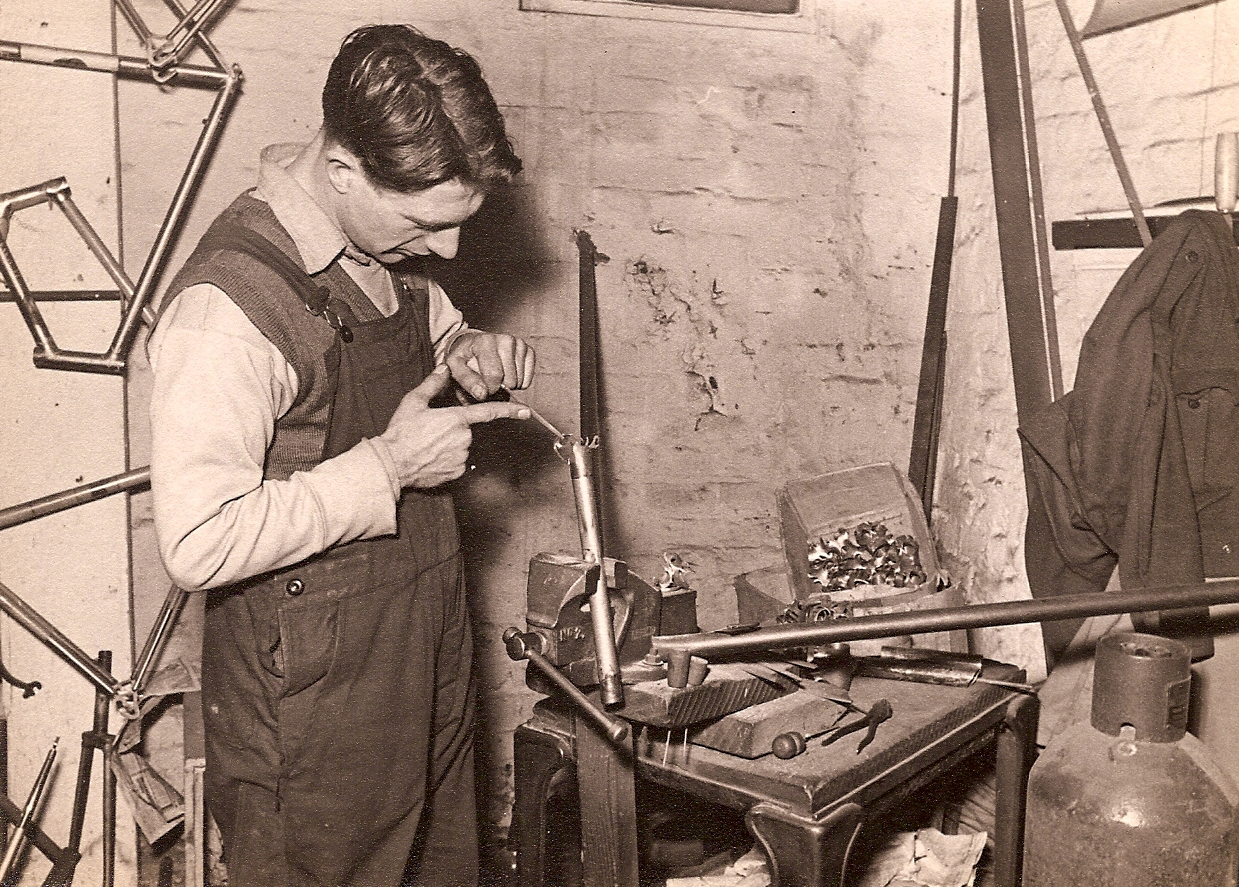
Working conditions were often terrible (as the picture above shows) as business premises as well as domestic properties were in great demand. It is hard these days to imagine large swathes of rubble up to the size of football pitches, the result of war-time bombing for month after month.
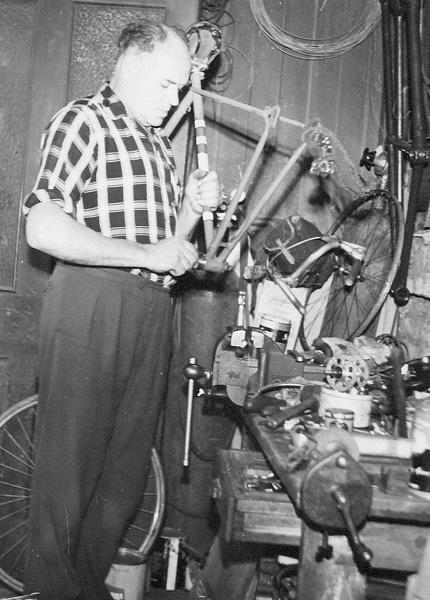
At school I remember fellow pupils with their legs in irons due to polio, some people moving to isolation sanatoriums with TB, and numerous instances of diphtheria and impetigo. Probably a majority of adults smoked and many frame builders died early from smoking-related diseases. I do have a wry smile when I hear people talking about the era as halcyon days. Many people in the trade would be affected by such health problems in their families, not helped by the living conditions of the time.
Carsten Rehbein from Germany
Here is my own bike, a lugless-welded Patria WKC from 1949. The Team bike from Sepp Berger, who won 3 stages in the German Tour 1949 with this bike and rode it until the season 1952. It is equipped with a 4 Speed Fichtel and Sachs Derailleur and a Racing Coasterhub. The Sachs 4-Speed model was for pro riders only and not sold to normal rider. The racing coaster hub was different to the normal coaster hubs for touring bikes. They used smaller spoke holes and a different body design. Sachs offered also a freewheel alloy hub with a cassette system, like Bayliss Wiley for 3 and 4-speed, produced 1936 up to the fifties. The Pennine Co2 bottle, Brooks B 17 saddle and wooden rims are not original. Interestingly there is an 18-minute video of the race on Youtube at https://youtu.be/Gz_RnZDk9Ow
You can see the machine in several of the close-ups. Although the commentary is in German most of the happenings are self-explanatory and it gives an interesting insight into road racing in Germany in the immediate post-war era.
Patricia and I had been to a couple of classic cycle meets in Bavaria where we realised that, along with classic Italian machines and a handful of British bikes, there is a local scene not often seen outside of Germany.
These days Germany has become quite a hot-bed for the production of top-end carbon machines including Canyon, Focus, Ride, Lightweight Urgestalt and ax-lightness. Lightweight are also famous for producing very top-of-the-range ultra-lightweight road racing wheels.
Scroll down for a Classic Cyclists crossword compiled by our South African correspondent with a piece by Eric Watts separating the puzzle from the answers. The reason I mention this is that it is possible that in your viewer the page gets divided from this text as people use all sorts of devices to view websites these days. (Ed.)
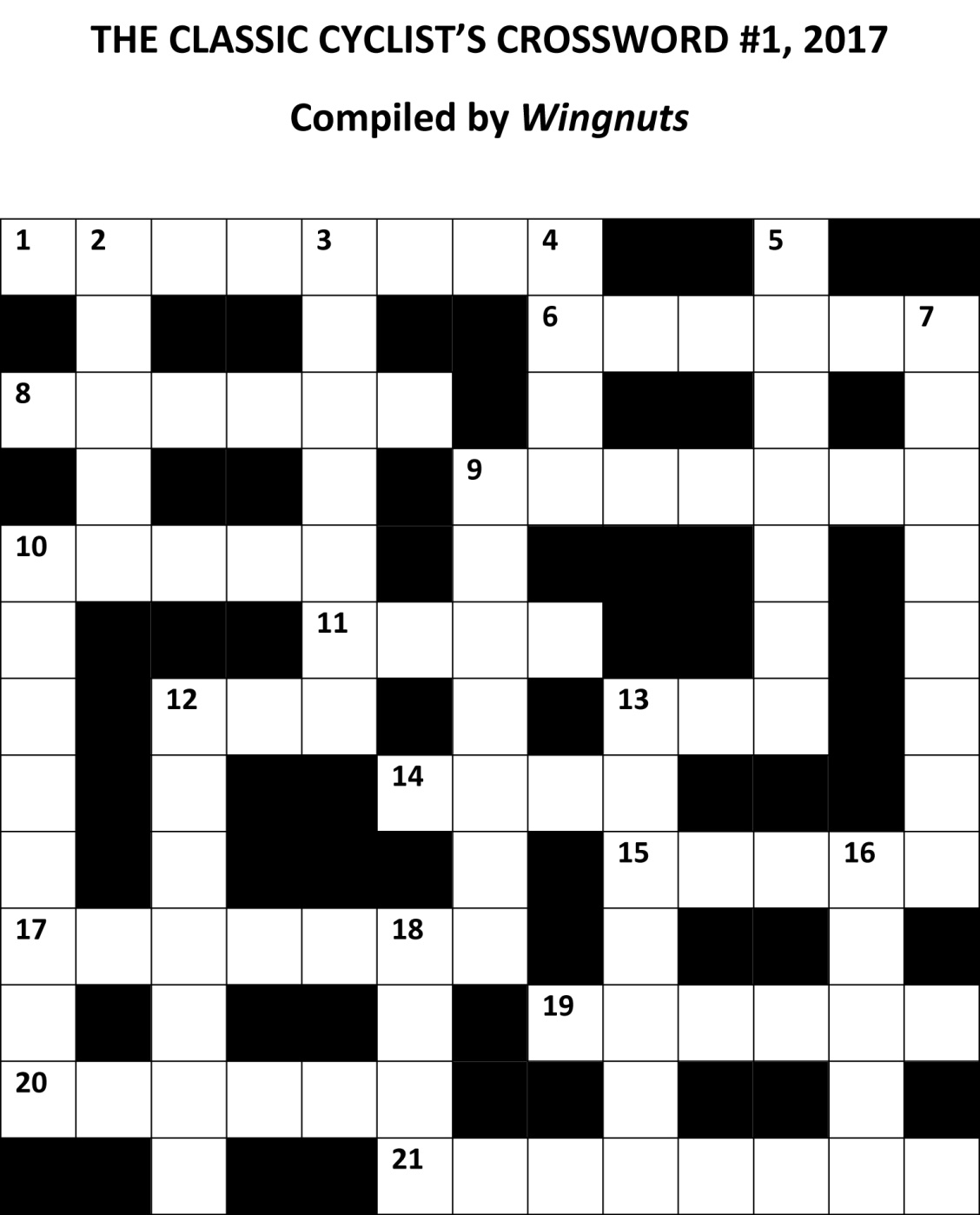
ACROSS
1. What team mates do in a cycle race bunch to protect a member of their team who has broken away and is ahead. (4, 4)
6. When the traditional season- opening annual race meeting was held at the historic London track in 10 and 14 across (5)
8. Famous Italian lightweight builder originally in Turin who sponsored the 1950 Swiss Tour de France winner, Ferdi Kubler, who died in 2016 aged 97 (6)
9. A ‘demi-fond’ track racing cyclist (1, 6)
10 & 14. Legendary South London outdoor cycling track (5 and 4)
11. Prefix of the top ‘—-corse’ model of classic lightweight constructed by Milanese lightweight builder, Santé Pogliaghi (4)
12. ‘— and Fiddle’: notorious UK climb between Buxton in Derbyshire and Macclesfield in Cheshire included in many versions of the 20th century British ‘Milk Race’ (3)
13. Surname of the pre-World War I Swiss hour record holder and noted lightweight component maker (3)
14. See 10 across (4)
15. Sign on a banner stretched over the road indicating the beginning of a road race (4)
17. Pace of a rider in a race who is suffering from the ‘bonk’ (1, 6)
19. The initials and the type of product fabricated by the co-sponsor of the professional Raleigh continental team of the 1970s and early 1980s whose logo appeared on the team’s kit (2, 4)
20. Surname of the star British short distance road time triallist of the 1960s and 1970s who broke the 50 minute 25 mile TT record in 1978 and became a cult figure in the sport (6)
21. A good reason for a rider in an individual time trial being disqualified (4, 4)
DOWN
2. Surname of a noted classic French touring lightweight frame builder and advocate of cycle touring and randonneur cycling (5)
3. Advice often given to cyclists about a crash helmet (2, 3, 2)
4. Surname of a noted mid-20th century West London lightweight cycle dealer and bespoke frame builder situated in Coldharbour Lane, Hayes (4)
5. One of two elements of a steel bottom bracket shell into which rear triangle tubing is brazed (4, 4)
7. What modern classic lightweight aficionados would term a ‘nos’ Campagnolo ‘Paris-Roubaix’ gear ensemble (4, 4)
9. Noted Italian alloy brand of tubular racing wheel components (3, 4)
10. Most prestigious ‘Blue Riband’ individual track record event (4, 4)
12. Iconic brand of classic Italian lightweight based in Cambiago near Milan (7)
13. Medium-sized British cycle manufacturer linked as co-sponsor of the ‘Hopper’ UK pro/independent cycling team of the 1960s (7)
16. Surname of the diminutive French winner of the 1947 Tour de France (5)
18. Overall race position of the ‘lanterne rouge’ in the Tour de France (4)
Sporting Britons –Eileen Sheridan 1954
Wheeling Along, Girls of the wheel brigade-1934
Pedalling British Pathe Bicycle History-1932
Cycling family -1961
Cycling Eves-1933
Brook land Cyclists 1937
Another champion another wheel 1932
Jane to Jollity 1936
Evelyn Hamilton long distance cyclist-1935
Kitchen Cyclist-Joyce Dean 1948
Pedal Pushers Open Six day1914-1919
Birth of the Bike 1937
The Penny Farthing Bike 1928
Sportshots-Frank Southall 1933
For the Olympic Games team 1932
Cycling Tips 1936-Evelyn Hamilton
Cycling Sins 1936- Evelyn Hamilton
And now meet the super cyclist-Alma 1930
Armchair cycling 1932-Velocar -Evelyn Hamilton
The evolution of cycling 1931
Another Champion-A Wheel One – 1932
Girl Cyclists 1954
Roller Racing1945-1946-Marguerite Wilson
Eve on the Track-1932
Airways Girl 1948-Marguerite Wilson
Good luck Go with you-1932-Olympic team on board ship.Bill Harvell.
CROSSWORD #1 2017 ANSWERS
ACROSS
1. Shut Door. This tactic involves blocking by team members at the front of the bunch and /or chasing down any rivals who try to escape off the front.
6. Easter. The first annual ‘Good Friday’ track meeting at Herne Hill was held in 1903. Traditionally, these season-opening meetings included top British and international track riders and attracted large crowds of spectators.
8. Frejus. The company was originally established by Emmo Gelfi in Turin, Italy, in 1896. It was taken over by Emilio Bozzi in 1946 and moved to his Milan factory where Legnano machines were also produced.
9. A stayer. Originally human paced by cyclists on solo, tandem, triplet and quint machines, these gave way increasingly to motorcycle and ‘derny’ moped pacers from 1900 onwards.
10 & 14. Herne Hill. Outdoor cycle racing track established in South London in 1891.
11. Ital. (‘Italcorse’). Santé Pogliaghi began lightweight frame building in Milan in 1947. His frames were ridden by many post-WWII stars including the Belgian six-day maestro, Patrick Sercu. When Pogliaghi himself retired in 1980, the brand name was taken over first by Rossin and then by Basso.
12. Cat.
13. Egg. Oscar Egg (1890-1961) held the unpaced World Hour Record for nearly 20 years from 1914 (distance covered: 44.247km.) until it was next broken in 1933 by Jan van Hout (distance covered: 44.588km.). Egg’s name is also associated with steel lug sets and the ‘Osgear’ derailleur mechanism.
14. See 10 across.
15. Start.
17. A snail’s. The ‘bonk’ can be counteracted by the rider eating some food.
19. TI tube. ‘Tube Investments’ (TI) was the holding company of Raleigh at that time. Hence the professional team was ‘TI Raleigh’.
20. Engers. Alf Engers. A cyclist from North London, he was a member of the Barnet CC and became a multiple British short distance time trial champion in the 1960s and 1970s. He was closely associated with the Alan Shorter brand of lightweight. Shorter, whose workshop was based in North London, built TT machines which were extensively ‘drilled out’ to increase their lightness.
21. Took pace.
DOWN
2. Herse. René Herse (1908-1976) was a leading French lightweight builder who produced noted touring, randonneur and racing machines. He supplied machines to Louison Bobet, who won three Tours de France (1953, 1954 & 1955).
3. Do use it. The wearing of a crash helmet remains controversial in cycling circles.
4. Rees. Mal Rees. He employed various leading steel frame builders including Bill Hurlow who built the eponymous ‘Rameles’ model with ornate lugwork. Rees later became a cycling journalist on Sporting Cyclist magazine.
5. Stay lug. Twin rear-facing lugs are moulded into the bottom bracket shell into which the chainstay and the offside stay, respectively, are brazed.
7. Rare part. The Campagnolo ‘Paris-Roubaix’ gear ensemble dates from the immediate post-WWII period. Gears were changed by the rider operating a lever on the right hand seat stay. This moved the rear wheel backwards and forwards along special toothed rear ends, taking up the chain slack as the gears were changed. Its use requires considerable skill on the part of the rider.
9. AVA rims. Italian-manufactured alloy lightweight tubular rims.
10. Hour race. The unpaced world hour record.
12. Colnago. Italian Ernesto Colnago established his racing frame building and lightweight business in 1952.Colnago machines are indelibly linked with Eddy Merckx and the ‘Molteni’ team of the 1960s and 1970s.
13. Elswick. The British Elswick Hopper bicycle manufacturer was established in 1913. In 1984 it changed its brand name to Falcon and later absorbed the Holdsworth and Claud Butler brands of lightweights.
16. Robic. Jean Robic (1921-1980) won the first post-WWII Tour de France in 1947. He took over the race lead only on the last day and final stage of the race.
18. Last. Celebrated ‘Lantern Rouge’ winners include the British rider, Tony Hoar, who finished the 1955 Tour de France in 69th and last place overall.
Posted: Thursday 16th March 2017
This article appears in the following categories.
Upcoming Events
Whether you are looking for a gentle social meet up, or a 100-mile ride browse the community’s upcoming events and plan your next weekend outing.


